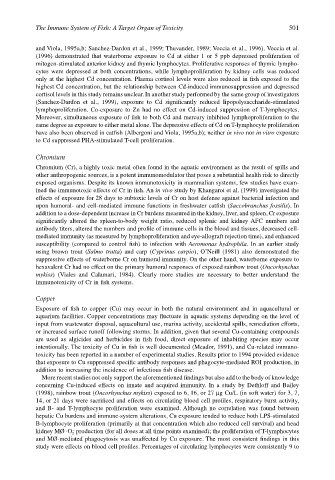Page 521 - The Toxicology of Fishes
P. 521
The Immune System of Fish: A Target Organ of Toxicity 501
and Viola, 1995a,b; Sanchez-Dardon et al., 1999; Thuvander, 1989; Voccia et al., 1996). Voccia et al.
(1996) demonstrated that waterborne exposure to Cd at either 1 or 5 ppb depressed proliferation of
mitogen-stimulated anterior kidney and thymic lymphocytes. Proliferative responses of thymic lympho-
cytes were depressed at both concentrations, while lymphoproliferation by kidney cells was reduced
only at the highest Cd concentration. Plasma cortisol levels were also reduced in fish exposed to the
highest Cd concentration, but the relationship between Cd-induced immunosuppression and depressed
cortisol levels in this study remains unclear. In another study performed by the same group of investigators
(Sanchez-Dardon et al., 1999), exposure to Cd significantly reduced lipopolysaccharide-stimulated
lymphoproliferation. Co-exposure to Zn had no effect on Cd-induced suppression of T-lymphocytes.
Moreover, simultaneous exposure of fish to both Cd and mercury inhibited lymphoproliferation to the
same degree as exposure to either metal alone. The depressive effects of Cd on T-lymphocyte proliferation
have also been observed in catfish (Albergoni and Viola, 1995a,b); neither in vivo nor in vitro exposure
to Cd suppressed PHA-stimulated T-cell proliferation.
Chromium
Chromium (Cr), a highly toxic metal often found in the aquatic environment as the result of spills and
other anthropogenic sources, is a potent immunomodulator that poses a substantial health risk to directly
exposed organisms. Despite its known immunotoxicity in mammalian systems, few studies have exam-
ined the immunotoxic effects of Cr in fish. An in vivo study by Khangarot et al. (1999) investigated the
effects of exposure for 28 days to subtoxic levels of Cr on host defense against bacterial infection and
upon humoral- and cell-mediated immune functions in freshwater catfish (Saccobranchus fossilis). In
addition to a dose-dependent increase in Cr burdens measured in the kidney, liver, and spleen, Cr exposure
significantly altered the spleen-to-body weight ratio, reduced splenic and kidney AFC numbers and
antibody titers, altered the numbers and profile of immune cells in the blood and tissues, decreased cell-
mediated immunity (as measured by lymphoproliferation and eye-allograft rejection time), and enhanced
susceptibility (compared to control fish) to infection with Aeromonas hydrophila. In an earlier study
using brown trout (Salmo trutta) and carp (Cyprinus carpio), O’Neill (1981) also demonstrated the
suppressive effects of waterborne Cr on humoral immunity. On the other hand, waterborne exposure to
hexavalent Cr had no effect on the primary humoral responses of exposed rainbow trout (Oncorhynchus
mykiss) (Viales and Calamari, 1984). Clearly more studies are necessary to better understand the
immunotoxicity of Cr in fish systems.
Copper
Exposure of fish to copper (Cu) may occur in both the natural environment and in aquacultural or
aquarium facilities. Copper concentrations may fluctuate in aquatic systems depending on the level of
input from wastewater disposal, aquacultural use, marina activity, accidental spills, remediation efforts,
or increased surface runoff following storms. In addition, given that several Cu-containing compounds
are used as algicides and herbicides in fish food, direct exposure of inhabiting species may occur
intentionally. The toxicity of Cu in fish is well documented (Meador, 1991), and Cu-related immuno-
toxicity has been reported in a number of experimental studies. Results prior to 1994 provided evidence
that exposure to Cu suppressed specific antibody responses and phagocyte-mediated ROI production, in
addition to increasing the incidence of infectious fish disease.
More recent studies not only support the aforementioned findings but also add to the body of knowledge
concerning Cu-induced effects on innate and acquired immunity. In a study by Dethloff and Bailey
(1998), rainbow trout (Oncorhynchus mykiss) exposed to 6, 16, or 27 µg Cu/L (in soft water) for 3, 7,
14, or 21 days were sacrificed and effects on circulating blood cell profiles, respiratory burst activity,
and B- and T-lymphocyte proliferation were examined. Although no correlation was found between
hepatic Cu burdens and immune-system alterations, Cu exposure tended to reduce both LPS-stimulated
B-lymphocyte proliferation (primarily at that concentration which also reduced cell survival) and head
–
kidney MØ ·O production (for all doses at all time points examined); the proliferation of T-lymphocytes
2
and MØ-mediated phagocytosis was unaffected by Cu exposure. The most consistent findings in this
study were effects on blood cell profiles. Percentages of circulating lymphocytes were consistently 9 to

